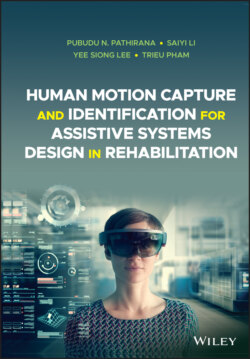Читать книгу Human Motion Capture and Identification for Assistive Systems Design in Rehabilitation - Pubudu N. Pathirana - Страница 21
1.4 Model‐based State Estimation and Sensor Fusion
ОглавлениеKinematic model‐based state estimation can often be used to estimate parameters of interest while combining different information available typically in real‐time applications. Let the N sensor measurements be and the unknown states of the dynamic system be . The dynamic system can be modelled in the form of a state space model,
(1.2)
(1.3)
where A, B and C denote the system matrices and w is the uncertainty input.
Three filters are commonly used to achieve the goal.
First of all, a Kalman filter is used extensively as an optimal state estimator under Bayesian assumptions and is extended to cover non‐linear dynamic and measurement models with stochastic, normal or Gaussian distributed noise [29, 210, 231]. This filter was introduced with the purpose of addressing the limitations of other filters in solving the Wiener problems [163]. Various versions of the Kalman filter, ranging from optimal (also called standard) to extended and various unscented versions pertaining to both linear and non‐linear systems have covered a large number of application scenarios. The proposed system is linear with position, velocity and acceleration acting as state variables, enabling the implementation of an optimal Kalman filter for data fusion. Detailed information about the Kalman filter can be found in Chapter 6. Although Kalman filtering is pervasive with the underlying assumptions of Gaussian noise or system uncertainty distributions, when the uncertainties deviate from these assumptions, the performance degradation can be significant and a more generic uncertainty assumption is warranted.
Secondly, particle filters, which are a form of sequential Monte Carlo sampling, are widely used for state estimation problems with both linear and non‐linear dynamic systems [172, 383, 385]. They relax the single Gaussian assumption in the state and the measurement uncertainties, allowing the handling of more complex noise situations via sampling from multiple probability densities. When this function is a single Gaussian, the particle filter essentially simplifies to the standard Kalman filter. The application of a particle filter in our linear system is described in Chapter 6.
